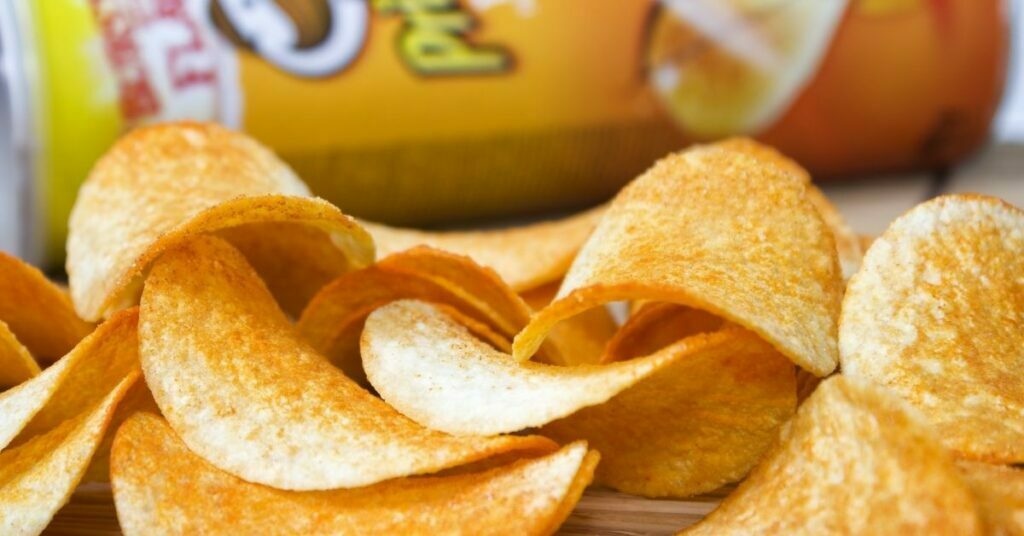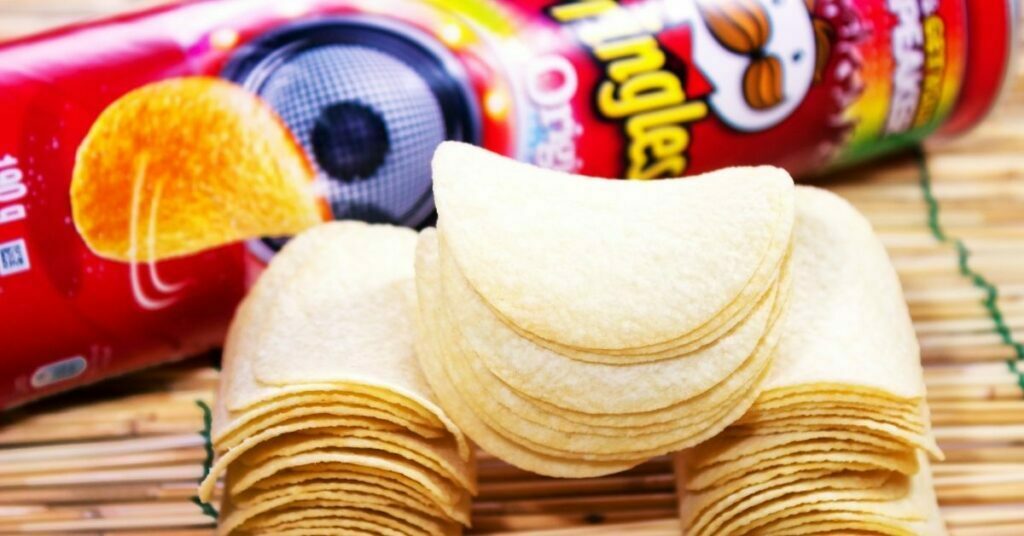How big is a Pringles can, and has the size of a can changed in recent years? What is the reason that Pringles come in a can anyway, and not in a bag like other potato chips? To answer these questions fully, we need to understand the origins of the product.
Pringles: a world famous brand
The American potato snack Pringles was first introduced in 1968, after over 10 years of research and development by Procter & Gamble (P&G). The goal was to improve existing potato chips on the market by designing a snack that would not break and crumble, would keep hands and clothes free of grease, and would stay fresh for longer than those of competitors.
It turns out that the can itself became one of the key factors in allowing for these benefits to be possible (and no air in bags).
Both the can and the new kind of potato chips were designed by chemist and technician Fredric J. Baur, who started working on the assignment in 1956. He experimented with fried dough and came up with a saddle-like shape for the chips such that they could be stacked and would not crumble.

Baur placed his chips in a robust tubular container for support (the big can), and invented a resealable plastic lid for it. However, he was not able to make the chips taste good enough, and so the work was put on hold for several years.
Later, Alexander Liepa managed to improve the taste, and P&G began selling them soon after. The original inventor Baur holds the patent for the can and the resealable lid, whereas the saddle-design was patented in the name of Liepa.
How the name on the can “Pringles” came about is uncertain. There are theories ranging from it being a random pick out of a hat to being the name of a potato-processing patent holder Mark Pringle.
P&G initially called its new product “Pringles Newfangled Potato Chips,” but had to change the text on the can from “chips” to “crisps” after competitors complained that they couldn’t be called potato chips. Competitors claimed that chips had to be actual slices of potatoes, whereas Pringles are fried dough. Interestingly, years later P&G themselves took the stand in court that they are not chips, in order to avoid taxes on potato-derived snacks. They initially won the case, but it was later repealed.
P&G sold the brand to another American food corporation Kellogg’s in 2012. Currently, they are available in tens of different flavors of the original chip design, and 4 additional flavors of a more crunchy and wave-textured “Pringles Wavy.”
Lightly salted and fat-reduced versions of the original also exist, as well as different-sized packaging for different occasions. Out of all of the flavors, the original basic potato flavor is the most popular, a Sour Cream & Onion flavor comes second, and Salt & Vinegar third.

Looking at the customer reviews, customers still appreciate the original improvements such as the chips not crumbling or spreading grease, and being easy to pack.
So being, it seems that the original ideas did provide a long-standing distinction from competitors, in which the patent of the can and the product have played a key business role. Indeed, advertising has focused on comparing the convenience of the snack to ordinary bag-served chips like Lays and Ruffles from the 1990s to this day.
As of now, Kellogg’s produces the Pringles in five locations around the world: one in the United States, two in Europe, and two in Asia.
How big is a pringles can?
But how big is a Pringles can exactly? In January 2022, Pringles decreased the size of their standard can to serving 165 g instead of the original 200 g. They did this for the stated reason of manufacturing costs having increased.
The new 165 g can is 23 cm or 9.06 inches tall, and 7.6 cm or 3 inches in diameter, whereas the old 200 g can was 25.9 cm or 10.2 inches tall, with the same diameter as the new one.
On the Pringles website, there is also the possibility of ordering an even smaller serving size of the original flavor, containing 149 g. The can for the 149 g is the same as the can for the 165g product.
To recap the size of a Pringles can:
- Original, 200 g (discontinued): 25.9 cm / 10.2 inches tall; 7.6 cm / 3 inches in diameter.
- New standard, serving 165 g or 149 g: 23 cm / 9.06 inches tall; 7.6 cm / 3 inches in diameter.
How many pringles are in a can?
One chip/crisp weighs around 2g, so in a big 200 g can there are around 98 of them. According to the Pringles website, the new 165 g cans contain about 90 chips/crisps, and the 149 g version around 73.

How many calories are in a can of pringles
One Pringle has about 10 calories, so the original large 200 g can served around 980 calories (98 Pringles * 10 calories). Similarly, the 165 g can serves around 900 calories and the 149 g can about 750 calories.
The macronutrient makeup of a Pringle that gives rise to these calories is around 32 mass-% fat (9% saturated fat), 57 mass-% carbohydrate (0% sugar), and 4 mass-% protein. In addition to the energy provisions, the new 165 g can of Pringles contains about 0.9 g of salt, 0.66 g of potassium, and 0.6 mg Iron.
The main ingredients that go into making the product are dried potatoes, vegetable oils, corn flour, rice flour, maltodextrin, emulsifiers, and wheat starch. So being, people with problems digesting wheat should be aware of possible complications.
This article has answered the question of how big a Pringles can is (the new 165 g can is 23 cm / 9.06 inches tall, and 7.6 cm / 3 inches in diameter), has provided background information on the brand and how the can came to be, and has reported on the nutritional values contained in the new serving sizes. We hope this provides adequate information to inform your purchasing decisions, and/or satisfies your curiosity after having seen the new cans.